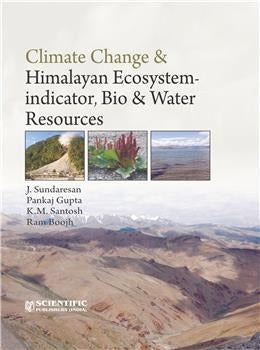Climate Change & Himalayan Ecosystem - Indicator, Bio & Water Resources
Climate Change & Himalayan Ecosystem - Indicator, Bio & Water Resources is backordered and will ship as soon as it is back in stock.
Couldn't load pickup availability
Genuine Products Guarantee
Genuine Products Guarantee
We guarantee 100% genuine products, and if proven otherwise, we will compensate you with 10 times the product's cost.
Delivery and Shipping
Delivery and Shipping
Products are generally ready for dispatch within 1 day and typically reach you in 3 to 5 days.
Authors: J. Sundaresan, P. Gupta, K.M. Santosh, R. Boojh
ISBN: 9788172338473
Book Format: Hard Bound
Language: English
Edition: 1
Imprint: Scientific Publishers
Year: 2013
Pages: 216
Size (Inch): 6.50 X 9.75
Weight: 500 Gms
Book Description:
This book, "Climate Change Himalayan Ecosystem-Indicator, Bio Water Resources," offers an essential compilation of data and information on the Himalayan region's climate change indicators, glaciers, water resources, and biodiversity hotspots. It presents an in-depth study of the effects of climate change on the Himalayan ecosystem, especially focusing on the retreat of glaciers and its impact on water resources.
Key topics explored in this book include:
-
Glacier Recession: The study on glacier recession in the Himalayas reveals that the fear of rivers drying up due to rapid glacier degeneration is not supported by historical data.
-
Watershed Management and DSS: A study conducted in the Central Himalayan watershed introduces a Decision Support System (DSS) as an interactive tool to help decision-makers understand and manage water demand and supply.
-
Himalayan Foreland Basin and Climate Records: Detrital records from the Ramganga sub-basin of the Himalayan Foreland Basin (11 to 5 million years ago) are examined to understand past climatic changes related to monsoonal circulation.
-
Biodiversity Conservation: The book provides a comprehensive discussion on Himalayan biodiversity conservation, emphasizing the current rate of species extinction and the potential challenges in biodiversity monitoring.
-
Carbon Sequestration Potential: The carbon sequestration potential of Himalayan forests is analyzed, highlighting their importance in mitigating climate change.
-
Impact on Butterflies and Vegetation: A detailed study of the altitudinal shift in butterflies in West Kameng district (Arunachal Pradesh) due to rising temperatures, along with changes in NDVI (Normalized Difference Vegetation Index), is included.





